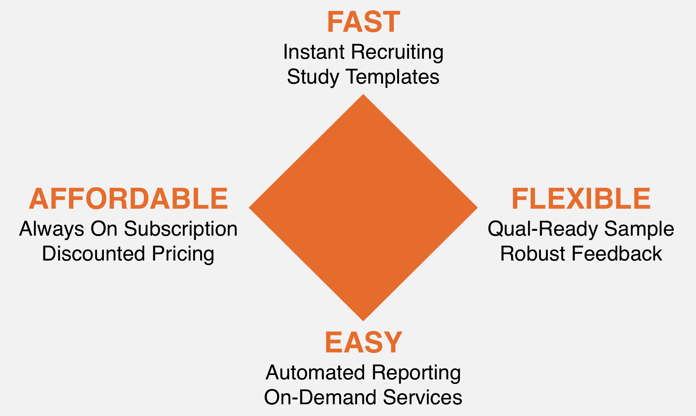Expectations for the Consumer Insights industry are changing. No longer is it acceptable to ask the marketing or R&D team to stop what they’re doing while we take time to conduct research. Nor does it work for us to simply go away and do research and expect results to be listened to. Instead, we need to do our insights work in an agile environment that allows for team engagement and constant progress, where we build and test solutions simultaneously. To do this, it’s important to choose and leverage the right market research technology.
- Working in small teams, giving them the autonomy to make faster decisions
- Breaking complex challenges into short sprints in order to solve more tightly scoped problems, iterating as we go
- Focusing on building and testing solutions simultaneously
- Executing fast consumer-driven feedback, within the building and testing cycles
- Integrating learning into a coherent whole—being part of the team, the strategy and the decision-making process

Agile Considerations
What should you look for when sorting through the different options for agile insights technology? It used to be “faster, cheaper, better,” but when I think about technology for agile qual and quant, I focus on not three but four considerations: fast, flexible, easy and affordable.

Fast
Quick turnaround is paramount. A few tech features that will speed things up are:- Instant recruiting. Some platforms can recruit participants in a few hours or overnight. My online research company, Digsite, can recruit overnight for both qual and quant, which is really important for faster results.
- Study templates will help you get up and launched quickly, instead of having to start from scratch. They can be tied to specialized reports, saving you time in both analysis and reporting. When selecting technology, make sure you understand the templates provided, how they work and what level of customization is available so you can be sure they meet your needs. If your company has unique needs, it’s likely you will require a platform that supports custom templates versus out of the box studies. This may dictate what solution provider you work with.
Flexible
To me, flexibility is the key part of agile, more so even than speed. What actually delivers speed is flexibility – being able to make decisions more frequently and earlier in the process, being able to change direction and iterate as we learn, and being able to improve as we go. This circular process is at the forefront of agile insights.
- Qual-ready sample. Digsite has built technology that allows you to quickly go from quant to qual – so if, during quant, you identify a participant you really want to talk to, or a group you want to subset out, you can get qual insights by scheduling a live video interview, bringing the participant into a discussion group, or having them screen record an experience.
- Robust feedback. The ability within the quant portion to get more robust feedback is very helpful. When researching your options, look carefully at the technology’s capabilities and its sample quality. For example, does it allow you to customize questions, mark things up, and have people write in responses? Can you get open-ends that are meaningful? Are you able to recontact participants and ask follow-up questions?
Easy
Technology should simplify your work. As you assess your options, think about your internal team and resources. How much bandwidth do they have, and how much expertise? A few features that can simplify agile research for your team are:
- Automated reporting. A dashboard allows you to see results in real time, which speeds up decision-making and works well for tracking studies. Consider whether dashboards handle open-ended responses and allow easy comparisons and stat testing. Technology that allows you to download results to PowerPoint, like Digsite’s soon-to-be-released SmartDashboard, allows you to quickly create customized presentations based on the dashboard attributes you want to show.
- On-demand services. You’ll find many DIY platforms out there, but if you’re on the client side, you may be managing too many projects to do everything yourself and may need help in the form of assisted DIY. If you choose assisted DIY (i.e., a tech partner that offers consulting services), they can handle the logistical part of the work, building efficiencies into your process so you can focus on the more value-added work. Having “assisted DIY” options built in is a huge benefit and much more seamless than having to go out and find separate consultants when you need extra help.
Affordable
Cheaper isn’t always better. A technology platform that is free or low cost often means fewer features, low-quality respondents and more work for your team. You want to look at both the quality and efficiency of the technology solution relative to the price.
- Always-on subscription. You can gain huge efficiencies by getting your team trained and up to speed on a technology and having it available whenever you have a project. It’s much faster than having to start from scratch each time.
- Discounted pricing. You can often see up to a 25% savings by having a technology subscription. That’s huge when compared to the small savings you see with long-term contracts for full-service vendors.
Getting started/next steps
If you’re looking to become more agile, evaluating new vendors or coming up with capabilities for next year, what are the next steps you need to take? Consider the following:
- Organizational readiness. Are you an embedded team, ready to be creative and help drive technology usage, or are you still reliant on full-service vendors for most or all of your research? Or are you somewhere in between? Make sure your technology partner can help train your team and support you through any needed organizational changes.
- Collaboration. Understand how your broader organization is going to collaborate to deliver agile decision making, and be clear on the role of other departments. If you’re going to provide results overnight but the marketing team says they’re going to take weeks to develop the ad, you may not be agile as an overall team.
- Retrospective. Plan for a retrospective review of your new agile research approaches. Go beyond whether the research got you what you wanted, when you wanted it. Take time to understand what went well and what didn’t with the research process itself so you can get better at being agile in the design and management of the research, and as an overall marketing or innovation team.
For more information on how to effectively combine qual+quant research, check out our new on-demand webinar, "Harnessing Agile Qual + Quant Research to Maximize Effectiveness."





